Adidas Takumi Sen 3 Review
A step in the right direction for Adidas?
The Adidas Takumi Sen 3 (2017 edition) is a lightweight racer for the neutral runner. It has an advertised heel-to-toe drop of 9mm (heel: 25.5 mm / forefoot: 16.5 mm) on the official Adidas website.
The Takumi Sen 3 sees significant changes from the previous versions. New models don’t necessarily translate to improvements from past iterations.
Did Adidas do things right in this version?

During some research, I found that the mesh was supposed to adapt to my foot. I found that the mesh was very stiff and required some expanding.
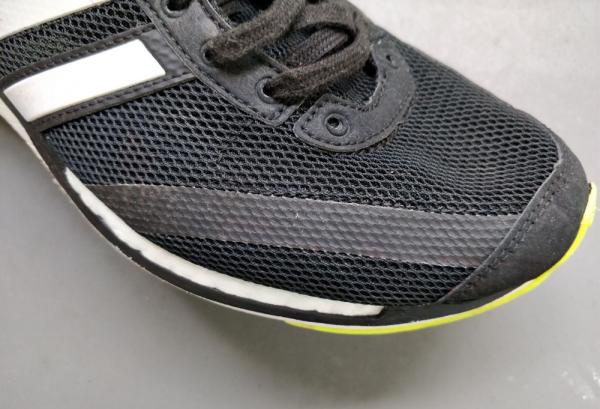
When I first put on the shoe, it was so tight that I was contemplating on selling it away. After a few runs and stuffing thick socks in the shoe whenever I wasn’t using them, the upper expanded quite a bit to the point where I did not feel that much irritation or tightness.
The shoe is still snug, but much better than it was out of the box. I had to switch up the lacing and skip the front laces together as it was too tight in the forefoot.
I found that the width in the midfoot was decent and wider than some of the other Adidas models but tapered in the forefoot which did not allow much toe splay.
The mesh felt decent when socks were used but were slightly abrasive when worn barefoot. I would not use this for a triathlon.
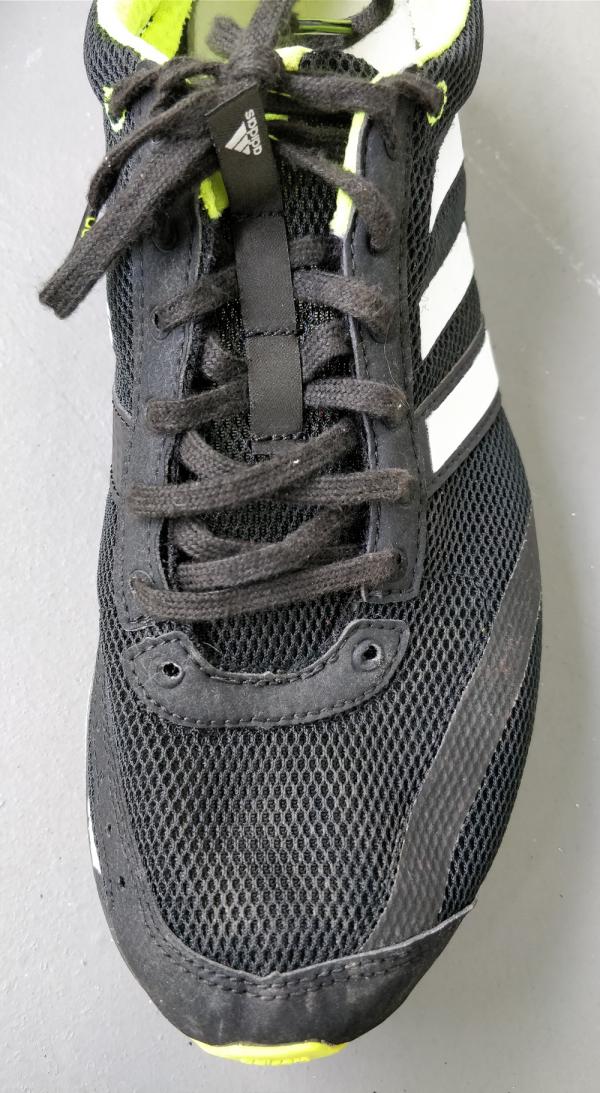
The heel counter in the 3’s seemed to be internal while the heel counter in the 3’s (2017 Version) looked like it got shifted to the external portion. This made no difference in the support and was unnoticeable when running.
There is not much going on in the ankle collar. The padding is minimal but sufficient.
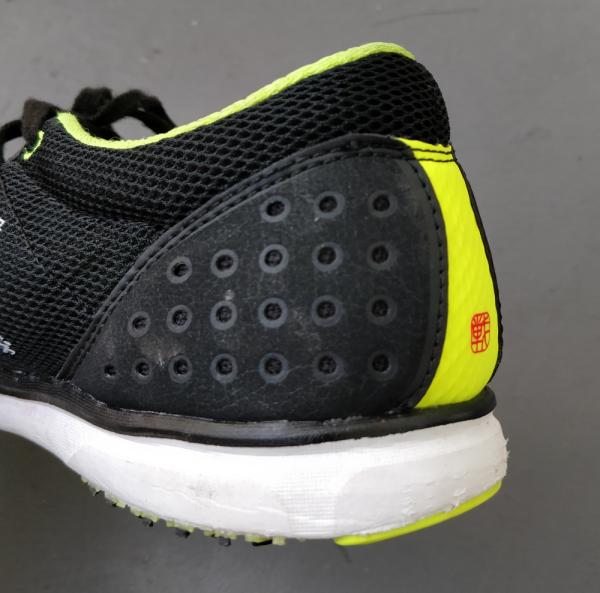
As mentioned above, the upper (including the tongue) can be rough when wearing the shoe barefoot. Triathletes should keep this in mind.
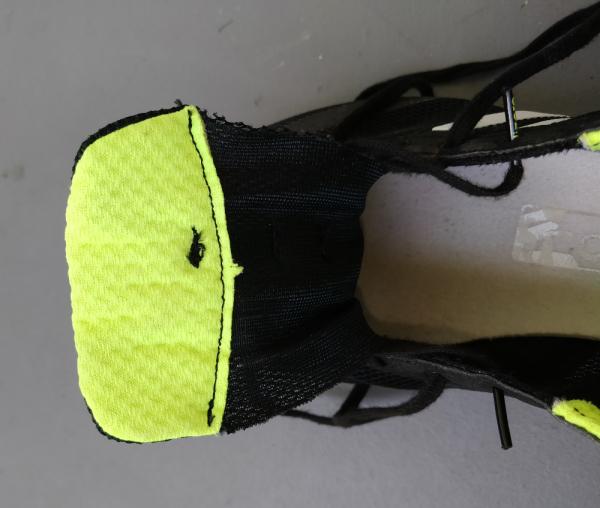
Adidas markets boost to be “our most responsive cushioning ever: The more energy you give, the more you get”. Boost is made up of tiny Thermoplastic Polyurethane (TPU) beads that are compressed together.
If you have not tried boost, now is a good time to start considering. Not including the ever so exclusive ‘Zoom X’ cushioning found in the Nike Vaporfly 4%, Boost is probably the most comfortable material I have tried on.
I have tried other companies’ midsole technologies; Saucony’s ‘Everun’, Asics ‘Dynaflyte’, Salomon’s ‘Energycell’, Nike’s ‘lunarlon’ and ‘zoom air’, New Balance ‘Revlite’, Under Armour’s ‘Charged foam’ and Brooks’ ‘BioMoGo DNA”.
The closest foam compound (based on softness and ride quality) to boost would be Reebok’s ‘Floatride’ foam, Saucony’s ‘Everun’ and Altra’s ‘Ego’.
A foam of such caliber still has its disadvantages. Boost is heavy.
The weight in the Takumi Sen 3 does not feel that evenly distributed due to the forefoot-only boost.
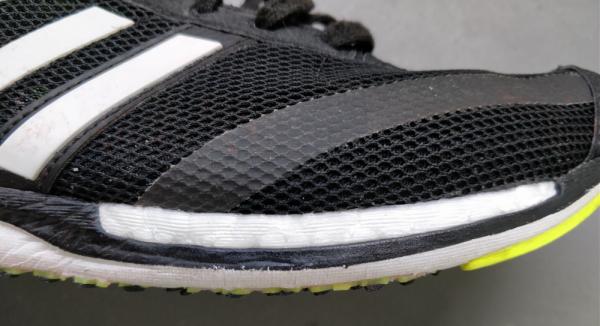
Lightstrike EVA is used in the rest of the midsole. In my opinion, Adidas slapped on a cheap slab of EVA foam and named it something fancy for marketing purposes.
Yes, the midsole is light. However, it feels dead and cheap. It is firm with almost zero bounce to it.
The redeeming factor is that the foam is not harsh on the foot. It softens quite a bit after breaking the shoe in but creases quickly.
Fortunately, I am a mid-forefoot striker which allows me to make more use of the boost cushioning in the forefoot.
The forefoot is soft and bouncy in the forefoot but manages to avoid being energy sapping. When I tried landing on the heel of the shoe, the ride felt dead and miserable to run in.
The presence of the torsion system helps with the overall stability in the shoe but does nothing more. I wish that Adidas extends the torsion system to the forefoot, much like the Adios Boost 2.
The torsion system present in version 2 of the Adios rewards you when the pace is picked up. After all, research has shown that stiffening the forefoot enhances the windlass mechanism of the foot.

This added some comfort due to the thick stack height but I would prefer a thinner piece instead.
The Continental Rubber is very sticky and grips well in both dry and wet conditions. The “Quickstrike” outsole is basically a “Dual-Stencil-Process” (DSP) construction that combines small pieces of rubber on the outsole with a fabric base.
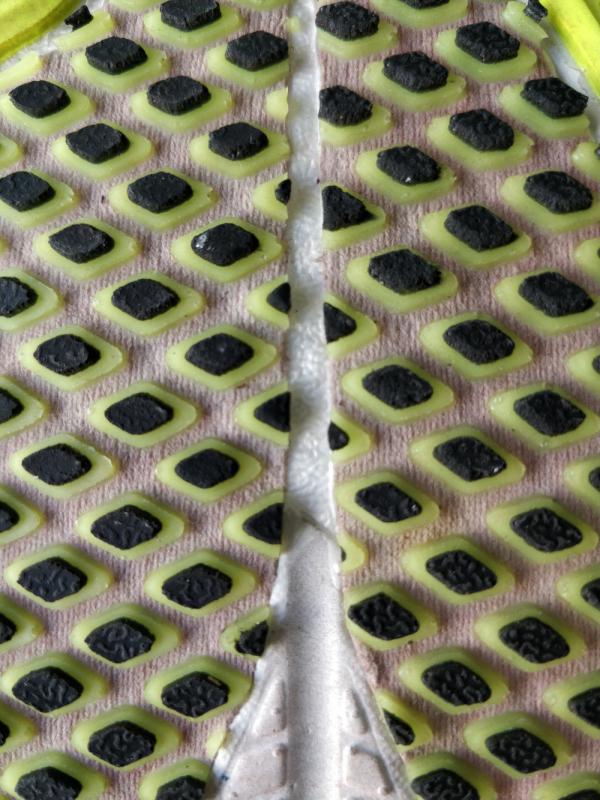
The combination of the materials resulted in an extremely grippy feel on both the road and track.
To put the grip of the outsole into perspective, I did not slip even once on the track while doing speed intervals after a heavy downpour that lasted for 4 hours.
I expect the continental rubber on the outsole to last a long time. The “Quickstrike” rubber nubs will probably be the first to wear out. After 40km of use, I can see some areas of wear on the rubber nubs.
The outsole lifespan can be estimated to last around the same mileage as other racing flats: 300-500km.
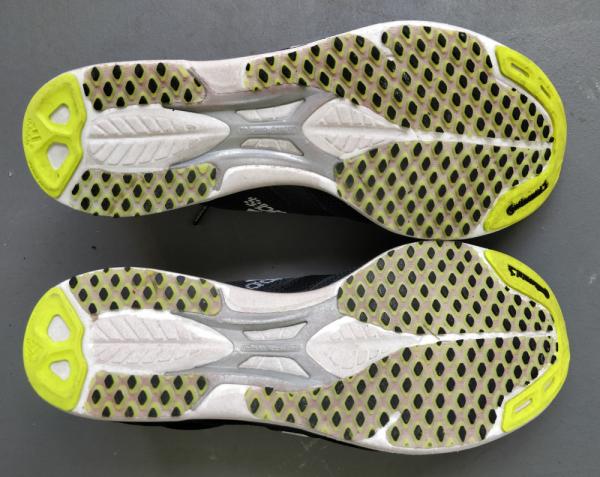
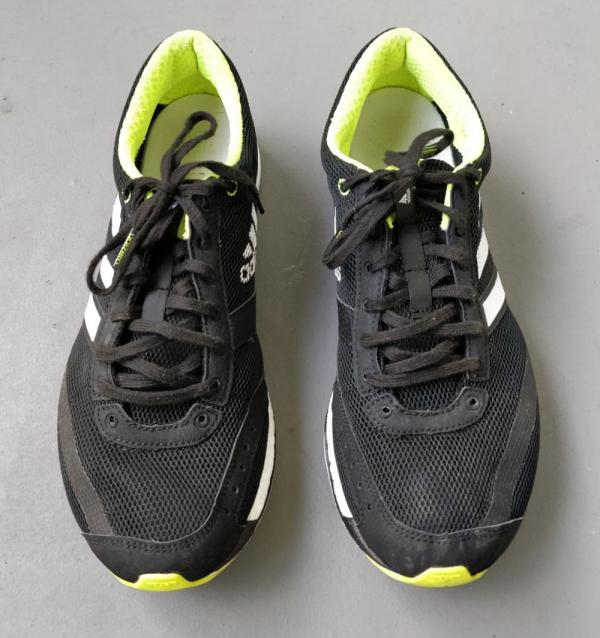
The plate in the previous version provided a lot of pop, a feature that many running shoe brands tend to leave out in their racers. The boost in the 3’s does give the shoe responsiveness but pales in comparison with the snappy ride of the 2’s.
The inclusion of the boost in the forefoot in the 3’s does give the forefoot more give than the 2’s. Runners who find the 2’s to be a firm shoe should definitely try the 3’s.
The Hyperion is much more flexible while the Takumi Sen 3 has a lot more grip.
The streak is much snappier due to the pebax plate that extends into the forefoot that becomes useful once my form gets sloppy.
Use the Takumi Sen 3 for anything up to 10km, and the zoom streak for anything more.
The only difference is that the Takumi Sen 3 is more forgiving in the forefoot due to the softer boost as compared to the rapid rebound insert in the Hanzo.
The Takumi Sen 3 sees significant changes from the previous versions. New models don’t necessarily translate to improvements from past iterations.
Did Adidas do things right in this version?

Upper
Adidas uses a simple and stiff mesh upper with overlays that provide structure and support in the midfoot and forefoot.During some research, I found that the mesh was supposed to adapt to my foot. I found that the mesh was very stiff and required some expanding.

When I first put on the shoe, it was so tight that I was contemplating on selling it away. After a few runs and stuffing thick socks in the shoe whenever I wasn’t using them, the upper expanded quite a bit to the point where I did not feel that much irritation or tightness.
The shoe is still snug, but much better than it was out of the box. I had to switch up the lacing and skip the front laces together as it was too tight in the forefoot.
I found that the width in the midfoot was decent and wider than some of the other Adidas models but tapered in the forefoot which did not allow much toe splay.
The mesh felt decent when socks were used but were slightly abrasive when worn barefoot. I would not use this for a triathlon.

Heel counter/Ankle Collar
The heel counter is supportive but not intrusive.The heel counter in the 3’s seemed to be internal while the heel counter in the 3’s (2017 Version) looked like it got shifted to the external portion. This made no difference in the support and was unnoticeable when running.
There is not much going on in the ankle collar. The padding is minimal but sufficient.

Tongue
The tongue is thin with sufficient padding to protect the top of the foot from possible lacing pressure.As mentioned above, the upper (including the tongue) can be rough when wearing the shoe barefoot. Triathletes should keep this in mind.

Lacing
The laces fall in the sweet spot of thickness and length. However, they are stiff. Having slightly more stretchy laces will help to provide a more customised fit.Sizing
The Takumi Sen 3’s sizing depends on the width of your foot. For narrower feet, go true to size. For medium to wide feet, go half a size up from your regular size.Midsole Technology & Ride Quality
The midsole consists of Lightstrike EVA with an inclusion of boost cushioning.Adidas markets boost to be “our most responsive cushioning ever: The more energy you give, the more you get”. Boost is made up of tiny Thermoplastic Polyurethane (TPU) beads that are compressed together.
If you have not tried boost, now is a good time to start considering. Not including the ever so exclusive ‘Zoom X’ cushioning found in the Nike Vaporfly 4%, Boost is probably the most comfortable material I have tried on.
I have tried other companies’ midsole technologies; Saucony’s ‘Everun’, Asics ‘Dynaflyte’, Salomon’s ‘Energycell’, Nike’s ‘lunarlon’ and ‘zoom air’, New Balance ‘Revlite’, Under Armour’s ‘Charged foam’ and Brooks’ ‘BioMoGo DNA”.
The closest foam compound (based on softness and ride quality) to boost would be Reebok’s ‘Floatride’ foam, Saucony’s ‘Everun’ and Altra’s ‘Ego’.
A foam of such caliber still has its disadvantages. Boost is heavy.
The weight in the Takumi Sen 3 does not feel that evenly distributed due to the forefoot-only boost.

Lightstrike EVA is used in the rest of the midsole. In my opinion, Adidas slapped on a cheap slab of EVA foam and named it something fancy for marketing purposes.
Yes, the midsole is light. However, it feels dead and cheap. It is firm with almost zero bounce to it.
The redeeming factor is that the foam is not harsh on the foot. It softens quite a bit after breaking the shoe in but creases quickly.
Fortunately, I am a mid-forefoot striker which allows me to make more use of the boost cushioning in the forefoot.
The forefoot is soft and bouncy in the forefoot but manages to avoid being energy sapping. When I tried landing on the heel of the shoe, the ride felt dead and miserable to run in.
The presence of the torsion system helps with the overall stability in the shoe but does nothing more. I wish that Adidas extends the torsion system to the forefoot, much like the Adios Boost 2.
The torsion system present in version 2 of the Adios rewards you when the pace is picked up. After all, research has shown that stiffening the forefoot enhances the windlass mechanism of the foot.

Sockliner
The sock liner is made of a lower density EVA foam that is glued into the midsole to prevent any sliding or slippage in the shoe.This added some comfort due to the thick stack height but I would prefer a thinner piece instead.
Outsole & Durability
The outsole composes of Continental Rubber in the forefoot and rearfoot while the rest of the outsole is made from a “Quickstrike” outsole.The Continental Rubber is very sticky and grips well in both dry and wet conditions. The “Quickstrike” outsole is basically a “Dual-Stencil-Process” (DSP) construction that combines small pieces of rubber on the outsole with a fabric base.

The combination of the materials resulted in an extremely grippy feel on both the road and track.
To put the grip of the outsole into perspective, I did not slip even once on the track while doing speed intervals after a heavy downpour that lasted for 4 hours.
I expect the continental rubber on the outsole to last a long time. The “Quickstrike” rubber nubs will probably be the first to wear out. After 40km of use, I can see some areas of wear on the rubber nubs.
The outsole lifespan can be estimated to last around the same mileage as other racing flats: 300-500km.

Type of workouts
The Takumi Sen 3 can be used on the track and the road for intervals, speed training and races of up to 10km.
Significant Changes from Previous Versions
Adidas removed the much-loved forefoot propulsion plate found in the 2’s. Perhaps the reasoning behind this move was that the plate would dull the sensation of the boost.The plate in the previous version provided a lot of pop, a feature that many running shoe brands tend to leave out in their racers. The boost in the 3’s does give the shoe responsiveness but pales in comparison with the snappy ride of the 2’s.
The inclusion of the boost in the forefoot in the 3’s does give the forefoot more give than the 2’s. Runners who find the 2’s to be a firm shoe should definitely try the 3’s.
Pros
- Lightweight
- Forefoot boost
- Grippy outsole
- Breathable upper
- Sleek design
Cons
- Upper is slightly abrasive
- Forefoot is cramped
- Heel to toe drop feels lower than advertised
- Cheap EVA midsole
- Not as snappy as previous versions
Recommended runner’s profile for optimum performance
- Neutral gait
- Running pace of <3:45min/km (6:02min/mi)
- Midfoot to forefoot striker
- Efficient gait
Potential Areas for Improvement
- Upper that is slightly more stretchy
- Less drastic taper at the forefoot
- Adding back the forefoot propulsion plate from the previous versions
- Switching the cheap EVA foam midsole with a livelier compound
Comparisons
Adidas Takumi Sen 3 vs Brooks Hyperion
The heel-to-toe drop of the Hyperion feels significantly more compared to the Takumi Sen 3. The Takumi Sen 3 is more cushioned in the forefoot while the Hyperion is more cushioned in the heel.The Hyperion is much more flexible while the Takumi Sen 3 has a lot more grip.
Adidas Takumi Sen 3 vs Nike Zoom Streak 6
Like the Hyperion, the streak has a higher heel-to-toe drop, less cushion in the forefoot and more in the heel due to the zoom air unit located in the rear.The streak is much snappier due to the pebax plate that extends into the forefoot that becomes useful once my form gets sloppy.
Use the Takumi Sen 3 for anything up to 10km, and the zoom streak for anything more.
Adidas Takumi Sen 3 vs New Balance Hanzo S
The Takumi Sen 3 and Hanzo S ride very similarly. The grip on both shoes are equally as great and are of similar flexibility.The only difference is that the Takumi Sen 3 is more forgiving in the forefoot due to the softer boost as compared to the rapid rebound insert in the Hanzo.
Conclusion
The Adidas Takumi Sen 3 is a great offering from Adidas for anyone who wants a light, cushioned and grippy shoe for 5-10 km races.[This shoe was sponsored by runrepeat.com for the purposes of a review. All reviews written are unabiased and for the purposes of aiding others in their shoe selection]
Comments
Post a Comment